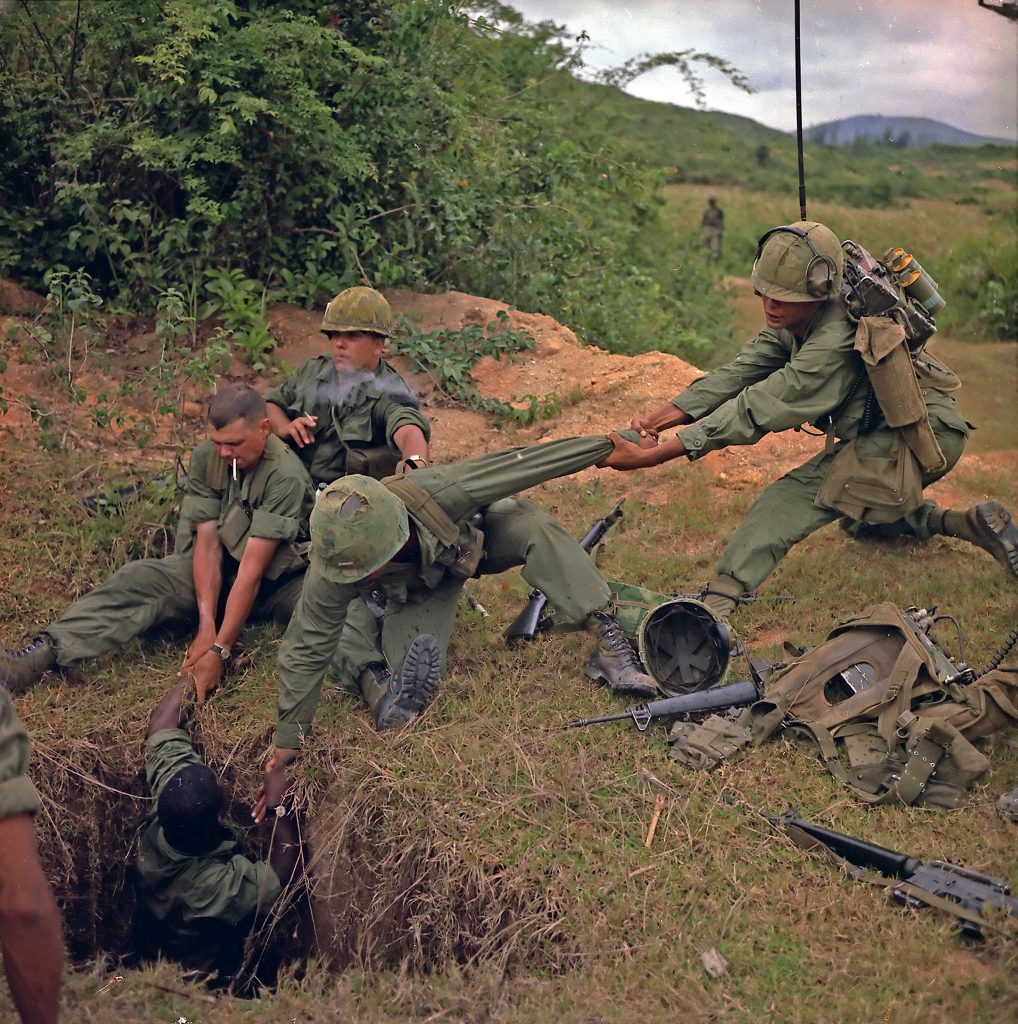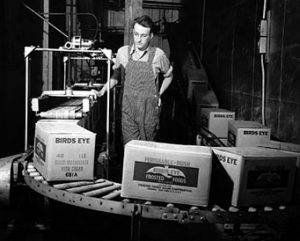If you ever see a flashlight coming your way, you can fire away, but more than likely, you are already a dead man.1
January 7, 1966. The war in Vietnam was raging and the United States had only just begun sending regular combat units as opposed to advisers the year prior. President Lyndon Baines Johnson was steadily escalating the United States’ involvement in Vietnam in an effort to “combat communism.” Eight thousand men descend on a freshly bombed area, hoping to clean up the remnants of Viet Cong in a search and destroy operation. However, when they approached the bombed area, known as the Ho Bo woods, they found nothing but empty fortifications and some rice, evidence that there were once many more men there. The leaders of the Joint American-Australian force were stumped. Where could the Viet Cong have gone?2

They received their answer when one young American soldier sat down to rest, then began exclaiming that he had been stung or bitten on his nether regions. As he began to search for the offending creature, he discovered that what had “stung” him was a nail, protruding from a wooden hatch. This hatch covered a massive underground complex known as the Cu Chi tunnels, spanning some fourteen miles; and this was only one of many tunnel complexes in South and North Vietnam.3 The presence of these tunnels meant that future search and destroy operations would be failures as well, if the tunnels were not dealt with. These tunnels gave the Viet Cong a way to attack U.S. troops from behind, after they had passed overhead; then they could quickly slip back into their tunnels and seemingly vanish. The tunnels also allowed them to hide during bombing runs and as American tanks and helicopters flew by, effectively hiding them from the brunt of American military might. The tunnels could be destroyed using explosives, but these tunnels housed barracks, ammunition and food depots, hospitals, clinics, armories, and rooms with vital military intelligence. These things were often too deep in the tunnels to be destroyed by a blast at the mouth of the tunnel, as the Viet Cong designed their tunnels so that blasts could only destroy small segments. The tunnels were very well made, with sharp right angles every few meters to baffle the blast of an explosive charge, and they had breathing holes dug by taking rabbits and gophers to the bottom of a tunnel and letting them dig themselves back to the surface. After several attempts using tear gas, Acetylene gas, and explosives to flush out the tunnels failed, a new plan emerged. Someone would have to enter the tunnels.4
And thus, the “tunnel rats” were born. These were men, generally small in stature to better fit the small tunnels designed for the smaller Vietnamese physique, and without fear of tight spaces or total darkness, although these are things many tunnel rats would develop after their time in the underground complexes. Armed with nothing more than a flashlight, which was hardly ever used for fear it would alert Viet Cong to the Tunnel rat’s location, a handgun, and a combat knife, sometimes wearing a battery-powered headset, connected to a long cable to let them relay information back to their comrades waiting at the mouth of the tunnel, these men would be lowered into a tunnel, and begin their search.5 Originally made up of men from the famous “Big Red One” 1st Infantry Division present at the original discovery of the Cu Chi tunnels, “tunnel rats” became an unofficial description for someone who had volunteered for this job. This work was mentally and physically taxing, with many volunteers giving up the duty after a few runs, or in many cases, a close call with a Viet Cong soldier in the dark confines of a cave.6
Part of the reason it was such a loathed experience was due to how dangerous an ordeal exploring the tunnels was. If an American tunnel rat were to run into a Viet Cong soldier, the encounter would devolve into hand to hand combat, as firing one’s pistol was very dangerous in tunnels that were barely shoulder-width.7 Firing the large .45 caliber M1911A1 pistol one was issued would definitely lead to ruptured eardrums. This led many of these men to bring captured Vietnamese-used Russian pistols or guns brought from home that were of a smaller caliber–.22 and .38 caliber revolvers being particularly common–that could be more safely fired in the small confines of the tunnels.8

The dangers did not end there either, as the tunnels were frequently booby-trapped, sometimes even with poisonous or venomous snakes and insects, or they had dangerous pits filled with water or gas designed to keep these things away from their living areas of the tunnels. The tunnels were frequently incredibly hot and humid, cramped, sometimes as small as 2.6 feet tall by 2.5 feet wide, and full of unpleasant stagnant air, prompting many tunnel rats to don gas masks in an attempt to make breathing easier.9 Even exiting a tunnel was not safe, as a tunnel rat could travel some distance while underground, then emerge elsewhere, potentially startling a nearby American soldier, which could lead to him being shot. Many tunnel rats would bring smoke grenades with them to use to alert any nearby troops that a friendly would be emerging from a tunnel.10 Because of these hardships, tunnel rats soon gained a reputation as being very courageous, smart, and incredibly lucky to escape a tunnel without dying, and the tunnel rats themselves began to use the motto “Non gratum anus rotendum” or “not worth a rat’s ass.”11
Even with these difficulties, the majority of tunnel rats were very successful. The tunnel rats of the 1st Infantry Division, the only one with any kind of formal training, was especially successful. Consisting of a number of men formally trained to enter the tunnels, radio operators to communicate with them, a medic and a pair of former Viet Cong who could act as translators, the team, led by Sargent Robert Woods, killed 3 Viet Cong soldiers and captured 153 more in a tunnel in August of 1968, just to name one of their most impressive raids. Outside of the formally trained 1st Infantry Division, the volunteer tunnel rats of other companies were sometimes successful as well, securing vital military intelligence, an enemy hospital, or sometimes stores of weapons; these captures accounted for a large portion of seized Viet Cong weapons.12
The tunnel rats where born out of necessity. The United States military had little experience with non-conventional warfare, and needed to adapt quickly to the guerrilla warfare employed by the Viet Cong. During the Vietnam War, even the Australian armed forces had their own “tunnel rats” whom they called “ferrets,” and with the Soviet war in Afghanistan in the 1980s, many Soviet soldiers faced similar hardships in the tunnels of the Mujahideen. Even today, the United States Marine Corps faces similar issues in fighting the Taliban in the cave-like “Kyareses,” or irrigation tunnels of Afghanistan.13 The tunnel rats of Vietnam were one of the first adaptations that the U.S. military made to prepare itself for a new type of warfare, unlike the conventional wars the U.S. had fought in before. But as the number of US casualties from Vietnam rose, American public opinion shifted from support to dissatisfaction, ultimately leading to the United States pulling out of Vietnam, but not before the United States military had learned valuable lessons about guerrilla warfare.

- James Gillam, “Death dance in the dark: James Gillam’s most terrifying moments in Vietnam came in the pitch-black darkness of an enemy tunnel,” Vietnam, 2011., 52, Academic OneFile, EBSCOhost ↵
- Encyclopedia of the Vietnam War: A Political, Social, and Military History, 2011, s.v. “CRIMP Operation,” by Chris Tomas. ↵
- Encyclopedia of the Vietnam War: A Political, Social, and Military History, 2011, s.v. “CRIMP Operation,” by Chris Tomas. ↵
- Encyclopedia of the Vietnam War: A Political, Social, and Military History, 2011, s.v. “Cu Chi Tunnels,” by Richard D. Starnes; “South Viet Nam: The Tunnel Rats,” Time, March 4, 1966. ↵
- Encyclopedia of the Vietnam War: A Political, Social, and Military History, 2011, s.v. “Tunnel Rats,” by James T. Gillam. ↵
- Encyclopedia of the Vietnam War: A Political, Social, and Military History, 2011, s.v. “Tunnel Rats,” by James T. Gillam. ↵
- “I’m not alone down here!” Vietnam, September/October 2015, 42. ↵
- “South Viet Nam: The Tunnel Rats.” Time, March 4, 1966. ↵
- Encyclopedia of the Vietnam War: A Political, Social, and Military History, 2011, s.v. “Tunnels,” by Scott R. Demarco. ↵
- “I’m not alone down here!” Vietnam, September/October 2015, 42. ↵
- George C. Herring, “Vietnam Remembered,” The Journal of American History 73, no. 1 (1986): 152-64; Encyclopedia of the Vietnam War: A Political, Social, and Military History, 2011, s.v. “Tunnel Rats,” by James T. Gillam. ↵
- Encyclopedia of the Vietnam War: A Political, Social, and Military History, 2011, s.v. “Tunnel Rats,” by James T. Gillam. ↵
- Timothy Gusinov, “‘Kyareses’: Taliban’s Death Trap or Escape Route?” Military Intelligence Professional Bulletin 28, no. 2 (April 2002): 46. ↵



58 comments
Abigale Carney
Very interesting article! I have heard of these tunnels before, but never suspected the dangers of them. I always thought these tunnels just provided easy transportation for the Japs to get around without being seen by the Americans. The fact that the tunnels were filled with booby traps is insane, as an American I feel that we would’ve used those tunnels to our own advantage and completely not think of the hidden traps. Great article!
Troy Leonard
until I read this article I have never heard of a tunnel rat. Its interesting to think how they even came to find out about the tunnels. with out the solider having a little accident there’s no telling when they would have found out about the tunnels. you did a great job on giving us insight in what it was like to go through he tunnels and what kind of obstacles they had to go through to get down there.
Valeria Hernandez
Nelson Smithwick talks about the roles of tunnel rats. This is an interesting topic because when someone talks about the Vietnam War people don’t usually think about the opposing side. The author is able to tell the story of the tunnel rats perfectly by describing their job descriptions and providing astonishing images. A clear testimony of the struggles of the brave soldiers who took on the role of being tunnel rats during the Vietnam war.
Alondra Aviles
Tunnel rats and the vast connection of tunnel systems were one of the reasons why America ‘lost’ the Vietnam War. Reading this reminds us of how unforgivingly clever the vietnamese were, and that not all enemies will fight conventionally. The article explicitly explains the struggles of being a “tunnel rat” and how unforgiving the war was. Evidently the article was very well detailed and well written. I was not aware of many of the things that soldiers had undergone, doing so opens eyes for those who don’t understand the struggle of the Vietnamese war.
Justin Garcia
This is very well structured article. The topic itself is also very interesting. Many remember the propaganda during the war time and how we where making huge advancements against the Viet cong. This article reminds us that the war was not so one sided. The enemy was smart, and calculated they met our forces not with brute strength but strategic plans. This article helps to remind the U.S. that they shouldn’t underestimate the enemy no matter who it may be.
Thomas Fraire
I knew absolutely nothing about tunnel rats, but this article was really well written. From the very beginning starting with the title it drew me in. The story was really smooth and it didn’t feel choppy at all. The writer also found a way to link this article and connect with the reader on a more personal level with the quote Not worth a rats’ ass, because it’s a phase I’ve heard growing up I just never knew where it originated from.
Karla Chavana
Tunnel Rat: I Find this topic to be very rare however very informative. I had no prior knowledge on tunnel rats, but as I kept on reading the more extensive and detailed the article got. War is something unfortunate to all parties involved. This article is a reminder of the fighting and defending that was done; just soldiers trying to survive, while the main objective was to defeat and kill.
Anthony Robledo
I saw this title and was automatically hooked! Combine the great title and the vivid images and this article is awesome. you describe the crawling of the tunnels so well, I could only imagine how that would feel. The flashlight and pistol was all they had to defend themselves and that astonished me. Overall this article was entertaining and attention grabbing from start to end! Awesome job!
Alexis Soto
As someone who has taken more than a couple of military courses throughout my college years I am glad I found your article. This was an extremely fascinating and entertaining topic to read about. I had no idea of who or what the “tunnel rats” of Vietnam were. Reading of the complex tunnels designed and the creative tactics that was developed to combat the Vietcong was interesting.
Benjamin Voy
This was a very interesting topic for me because I had no idea these tiny tunnels existed. I am quite familiar with the Vietnam war but this was a new piece of information for me. Its extraordinary how these tunnels worked for the Vietnamese and even more so that the Americans were able to manoeuvre around them in order to fight back. Especially with such dangerous booby traps like venomous insects. A well written piece that I thoroughly enjoyed
Oceane Roux
What an incredibly interesting article! Hearing about the bravery required for this adapted need in the field is unbelievable. I can’t believe that men volunteered to do this on their own free will. This was such a strong display of service over self due to the dangers of death and harm to the “tunnel rats.” The tunnel rats are far too brave not to be talked about more often.